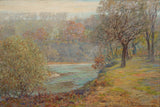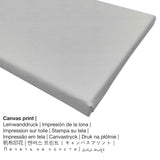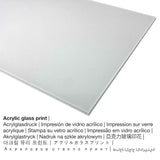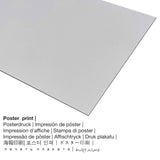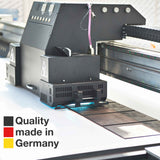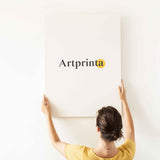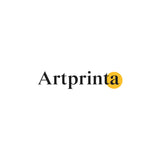John O. Adams, 1906 - Mgbụsị akwụkwọ - ọmarịcha akwụkwọ nka
Ụtụ gụnyere. Mbupu gbakọrọ na ndenye ọpụpụ.
Kedu ụdị ngwaahịa nka anyị na-egosi ebe a?
Na 1906 na nwoke artist John O. Adams made this modern art artwork "Late Autumn". The artpiece had the following size: 28 x 42 in and was painted with the techinque of mmanụ na kwaaji. The mpempe nka bụ nke dijitalụ art collection nke Analọ ihe nkiri nka nke Indianapolis. Site n'ikike nke: Analọ ihe nkiri nka nke Indianapolis (ọha na eze).: . Moreover, alignment of the digital reproduction is landscape with an image ratio of 3 : 2, meaning that ogologo bụ 50% ogologo karịa obosara.
Nweta ụdị ebipụta nka dị mma ịchọrọ
The product dropdown list ofers you the opportunity to pick your favorite size and material. Therefore, we allow you to choose among the following options:
- Mbipụta iko acrylic (nke nwere ezigbo mkpuchi iko): The acrylic glass print, which is sometimes referenced as a plexiglass print, changes your favorite original artwork into beautiful home décor and is a viable alternative to aluminium or canvas art prints. The artwork is printed with the help of modern UV direct print machines. It creates deep and rich color shades. The real glass coating protects your selected art print against light and heat for many more years.
- Metal (aluminium debond mbipụta): This is a metal print made on aluminium dibond material with an outstanding depth - for a modern look and a non-reflective surface. For the Aluminium Dibond option, we print your chosen work of art on the aluminium white-primed surface. The bright parts of the original artpiece shine with a silk gloss but without glare.
- Akwụkwọ mmado ebipụtara (akwa akwa akwa): The Artprinta poster print is a printed canvas paper with a slightly roughened texture on the surface, that reminds the actual version of the masterpiece. A print poster is suited for putting the art replica with a special frame. Please bear in mind, that depending on the absolute size of the canvas poster print we add a white margin of something between 2-6 cm round about the painting to facilitate the framing with your custom frame.
- Mbipụta kanvas: A printed canvas, which should not be mistaken with a canvas painting, is a digital image printed from an industrial printing machine. The great advantage of canvas prints is that they are relatively low in weight, meaning that it is quite simple to hang your Canvas print without any wall-mounts. Hence, a canvas print is suitable for all types of walls in your home.
Legal note: We try everything in order to describe our products in as much detail as possible and to display them visually in our shop. Nevertheless, the colors of the print products, as well as the imprint can differ somehwat from the representation on the monitor. Depending on the settings of your screen and the quality of the surface, not all color pigments can be printed as realistically as the digital version. Considering that all the art reproductions are processed and printed manually, there may as well be minor discrepancies in the exact position and the size of the motif.
Banyere ihe a
| Nkewa bipụta: | nka nka |
| Usoro mmeghari: | dijitalụ mmeputakwa |
| Usoro mmepụta: | Mbipụta UV ozugbo |
| Mmalite nke ngwaahịa a: | arụpụtara na Germany |
| Stockdị ngwaahịa: | mmepụta ihe na-achọ |
| Ihe eji eme atụmatụ: | ime ụlọ, ụlọ mmepụta nka nka |
| Nhazi: | usoro odida obodo |
| Oke akụkụ: | ogologo ruo obosara 3: 2 |
| Mmetụta akụkụ: | ogologo bụ 50% ogologo karịa obosara |
| Nhọrọ ihe dị: | mbipụta akwụkwọ mmado (akwụkwọ kwaaji), mbipụta kanvas, mbipụta enyo acrylic (nwere ezigbo mkpuchi iko), mbipụta ọla (aluminium dibbond) |
| Nhọrọ nha nha mbipụta kanvas (akwa akwa na etiti ihe ndọtị): | 30x20cm - 12x8", 60x40cm - 24x16", 90x60cm - 35x24", 120x80cm - 47x31", 150x100cm - 59x39" |
| Mbipụta iko acrylic (nke nwere ezigbo mkpuchi iko): | 30x20cm - 12x8", 60x40cm - 24x16", 90x60cm - 35x24", 120x80cm - 47x31" |
| Mpempe akwụkwọ mmado (akwụkwọ kwaaji) nha dị iche iche: | 60x40cm - 24x16", 90x60cm - 35x24", 120x80cm - 47x31" |
| Mbipụta nke aluminom: | 30x20cm - 12x8", 60x40cm - 24x16", 90x60cm - 35x24", 120x80cm - 47x31" |
| Nhazi mbipụta nka: | agunyeghi |
Nkọwa gbasara akụkụ nka
| Aha eserese: | "Late Autumn" |
| Nhazi: | sere |
| Okwu nche anwụ: | nkà nke oge a |
| oge: | 20th narị afọ |
| Emepụtara n'afọ: | 1906 |
| Afọ nka: | ihe karịrị 110 afọ |
| Agba na: | mmanụ na kwaaji |
| Nha nke ihe nka izizi: | 28 x 42 n’ime |
| Ụlọ ihe ngosi nka: | Analọ ihe nkiri nka nke Indianapolis |
| Ebe ngosi nka: | Indianapolis, Indiana, Njikota Obodo Amerika |
| Ibe weebụ: | Analọ ihe nkiri nka nke Indianapolis |
| Licensedị ikike: | ngalaba ọha |
| Site n'aka: | Analọ ihe nkiri nka nke Indianapolis |
Tebụl metadata omenkà
| Aha onye nka: | John O. Adams |
| okike nke onye nka: | nwoke |
| Nationality: | American |
| Ọrụ nke onye na-ese ihe: | onye na-ese ihe |
| Mba onye si: | United States |
| nhazi ọkwa: | omenkà nke oge a |
Enwere ikike nwebiisinka © | Artprinta (www.artprinta.com)
Nkọwapụta nka dị ka enyere site na ụlọ ngosi nka (© - Ụlọ ihe ngosi nka nke Indianapolis - Analọ ihe nkiri nka nke Indianapolis)
J. Ottis Adams was born in Amity, Indiana and settled with his family in Shelbyville, Indiana. The young Adams was fascinated with art and spent much of his time drawing. He enrolled in Wabash College but left a year later to study art at the South Kensington School in London where he came under the influence of John Constable and Joseph Mallord William Turner, whose landscapes were of particular interest to Adams. He returned to Indiana and settled in Muncie. In 1880, Adams traveled to Munich to study at the Royal Academy with fellow Indiana artists Theodore Clement Steele and Samuel Richards. Adams studied drawing and painting at the Academy and then set up his own studio in Munich. When he returned to Indiana in 1887, Adams set up a studio in Muncie and began teaching art classes. In 1889, he and fellow artist William Forsyth opened the Muncie Art School, which lasted two years. Adams participated in a group show of Hoosier artists that traveled from Indianapolis to Chicago. A critic dubbed the artists in the exhibition The Hoosier Group. Two years later, Adams, Forsyth and Steele along with other artists in the area, formed the Society of Western Artists, the first organization dedicated to promoting the work of the region’s artists. In 1898, Adams and T. C. Steele purchased a house in Brookville, Indiana later known as the Hermitage. In 1901, Adams became one of the first teachers at the newly built John Herron Art Institute where he taught from 1902 to 1906. During the latter part of his life, Adams worked in Florida and Michigan as well as Brookville.
Late Autumn conveys a misty November morning near the banks of the Whitewater not far from Adams’s Brookville home. The painting was purchased from the Eleventh Annual Exhibition of the Society of Western Artists. The Society held annual exhibitions until 1914 at six Midwestern cities. The John Herron Art Institute, now the Indianapolis Museum of Art, was the Indianapolis venue for the Society’s exhibitions. Many works by Midwestern artists, including Late Autumn were acquired from the museum’s contemporary collection from these exhibitions.

